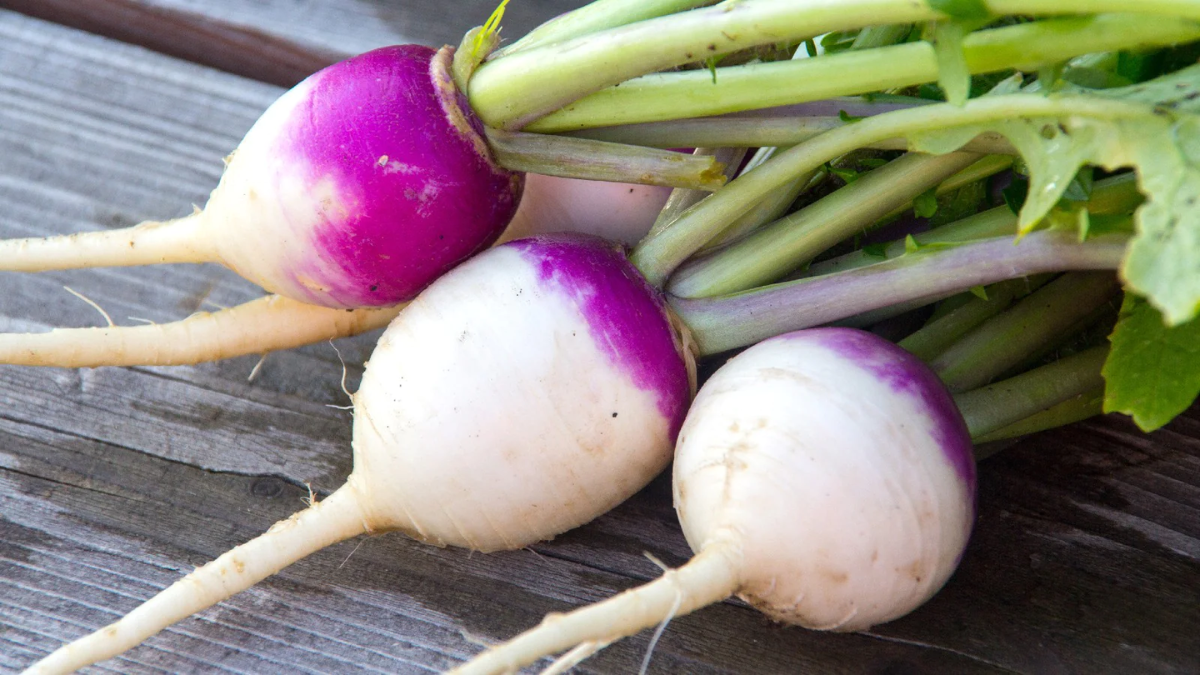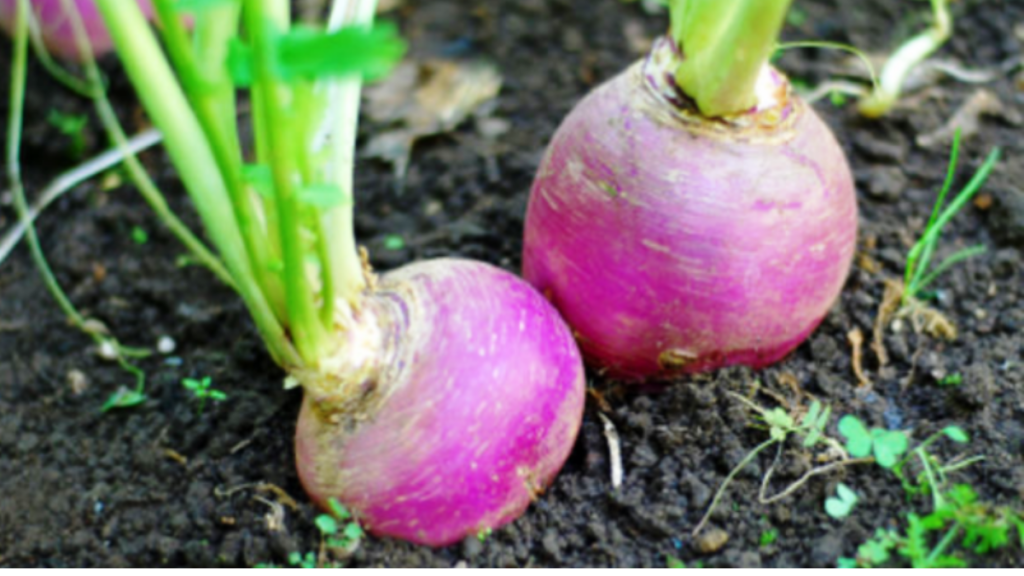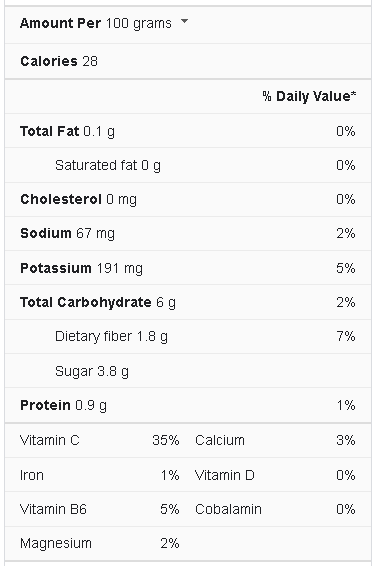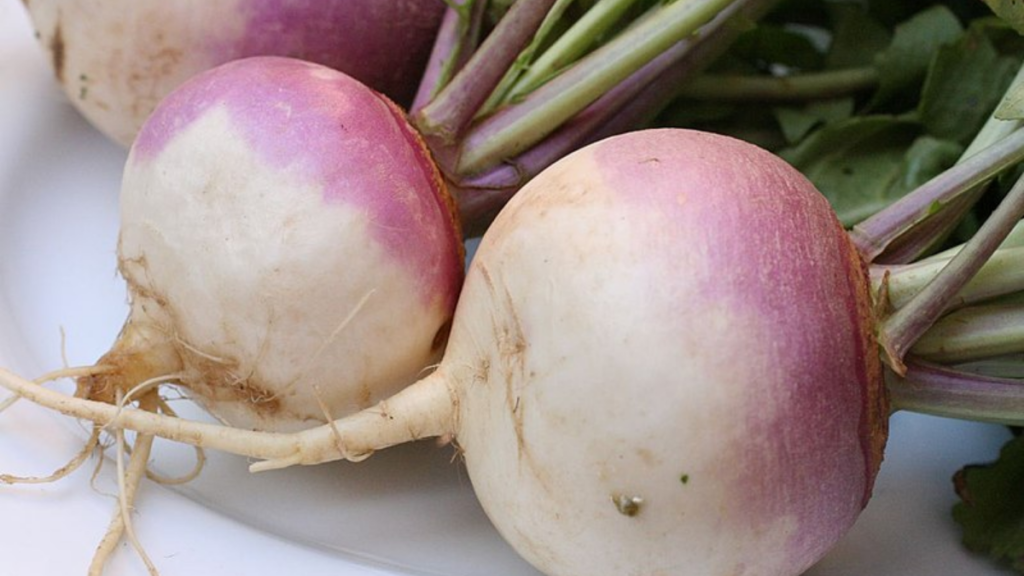Turnips are purple-topped veggies with a creamy white base. This traditional European staple meal is frequently associated with root vegetables like potato and beetroot. On the other hand, the turnip is a cousin of broccoli, Brussels sprouts, arugula, and kale. Like other cruciferous vegetables, turnips are high in nutrients and low in calories. Potassium is found in 191 mg per 100 grams of turnip. Your body requires that mineral for various functions, including helping your nerves relay signals and maintaining your muscles and heart in good operating order. To know turnip nutrition facts, read further.
Both the roots and the leaves are high in vitamin C, which protects your body from free radical damage when levels of these molecules in your body become too high. This mineral also helps manage blood cholesterol and promotes iron absorption, among other things. Furthermore, turnip greens are high in fat-soluble vitamins K and A, better absorbed by the body when ingested with lipids.
Turnip Nutrition Facts
What is Exactly Turnip?
Turnip, commonly known as white turnip, is a hardy biennial plant in the mustard family (Brassicaceae) grown for its fleshy roots and soft growing tops. Turnips are grown across the temperate zone and are assumed to have originated in middle and eastern Asia. Young turnip roots can be eaten raw or pickled in salads, and the young leaves can be cooked and served. The roots are frequently used in stews and are cooked and either whole or mashed. Rutabagas (Brassica napus, variety nap brassica) are a separate species from turnips, which are frequently referred to as yellow or wax turnips.
The turnip root is created by thickening the seedling’s primary root and the base of the young stem directly above it. The stem remains short during the first year and bears leaves that create a rosette-like bunch at the root’s top. The leaves are grass-green in color and have rough hairs on them. If let to grow for a second season, the rosette’s central bud develops into a strong, upright, branching stem with somewhat glucose (waxy) smooth leaves. Small cross-shaped bright yellow blooms cluster at the end of the stem and branches, followed by smooth, elongated short-beaked seed pods.
What are the Health Benefits of Turnip?
Many researchers and health professionals believe that turnips contain nutrients that provide a variety of health benefits, including:
Relieving Intestinal Problem
There are 1.8 grams of dietary fiber in a cup of raw turnips weighing 100 grams. Fiber aids in the reduction of intestinal pressure and inflammation. High fiber diets, in particular, are linked to a lower incidence of digestive disorders, such as diverticulitis. By absorbing water in the colon and making bowel movements more straightforward, turnips and other high-fiber meals can help lessen the frequency of diverticulitis flares. On the other hand, doctors do not always advise persons with diverticulitis to eat a high-fiber diet. Before consuming high-fiber foods, consult your doctor.
Lowering Blood Pressure
Foods containing dietary nitrates, such as turnips and collard greens, may give several benefits to the health of blood vessels, according to a 2013 study published in the British Journal of Clinical Pharmacology. These include lowering blood pressure and preventing platelets in the blood from sticking together. However, the long-term effects of a high-nitrate diet on cardiovascular health are unknown. A diet high in fruits and vegetables has lower blood pressure.
Reducing Cancer Risk
Consumption of cruciferous vegetables, such as turnips, cauliflower, and cabbage, has reduced cancer risk. These veggies include several chemicals that may help to protect against cancer. According to a 2016 assessment, one of them is 3,3′-diindolylmethane. Foods containing sulforaphane, a cancer-fighting chemical, may also have a role in cancer treatment. Sulforaphane is abundant in cruciferous vegetables, and Sulforaphane may interfere with histone deacetylase, an enzyme involved in the growth of cancer cells, according to a 2015 study.
Aiding Weight Loss and Digestion
Turnips and other cruciferous vegetables, high in fiber and low in calories, help individuals feel satiated for longer. Eating high-fiber meals also aids in the control of blood sugar levels. Turnips’ high fiber content may help avoid constipation and promote regularity, which is essential for a healthy digestive system. Toxins must be removed from the body through the bile and stool, which requires regular, sufficient bowel movements.
How to Add Turnips to Your Diet?
Turnips can be eaten both cooked or raw, and turnip greens make a great addition to salads.
Here are some ways to incorporate turnips into your diet:
- Add some boiled turnips to your mashed potato recipe.
- Thinly slice and bake them to prepare crunchy turnip chips.
- Mix cubed turnips with potatoes and carrots when grilling or roasting vegetables.
- Add some grated turnips to coleslaw for a more flavorful version.
- Sauté turnips and turnip greens for a healthy side of veggies.
Turnips are very easy to cook with, and adding them to some of your favorite dishes will surely enhance their nutritional value.
How to Select and Store Turnip?
Fresh turnips are available all year. However, supermarkets are flooded with fresher, sweeter roots from October through March. Tubers are typically two to three inches in diameter and weigh between 60 and 250 grams when fully grown. Fresh tubers are typically sold topped or in a bundle with top greens. Look for medium-sized, firm, spherical tubers with a delicate sweet flavor in the marketplaces.
More extensive and over matured roots should be avoided since they are hard, woody, and fibrous, and hence unappealing. When you get home, separate the top greens from the root since the greens deprive the tubers of nutrients. The roots can be kept for a few weeks in an excellent (32°-35° F) and humidified environment (95 percent or above). Because top greens lose nutrients quickly, use them as soon as possible.
Preparation and Serving Methods to Turnip
Cooking can be done with both the root and the top greens. Remove sand, soil, and any fungicide residues from the surface of the roots with cold running water. Trim the ends at the top and bottom. If the roots are young, peeling may not be necessary; nevertheless, large turnips have rough skin and must be peeled.
Here are some serving tips:
- Young turnips are one of the favored items in raw salads for their sweet taste, complementing cabbage, parsnips, carrots, and beets.
- Its cubes can mix well with other vegetables like kohlrabi, potato, and carrots to prepare a variety of stews.
- Diced turnip can be added to poultry, lamb, and pork.
- Add raw baby turnip slices with olives and cherry tomatoes to prepare a delicious appetizer.
- Turnip cubes can be pickled similarly to other vegetables like radish, chili-peppers, and carrots in many parts of Northern India, Iran, and Pakistan.
- Top greens are used with other greens and vegetables in soups, curries, and stews.
What are the Side Effects Of Turnips?
Turnips are cruciferous vegetables. According to anecdotal data, excessive use may induce bloating, gas, and stomach pain. Turnip glucosinolates and isothiocyanates may have a goitrogenic effect, and they have the potential to interact with thyroid hormones. Before eating turnips, anyone with thyroid problems should visit their doctor.
In persons who have kidney stones, turnips can cause difficulties. However, there is no evidence to support this claim. Though turnips may benefit kidney health, persons with kidney problems should get medical advice before eating them.
The numerous advantages of turnips can be linked to their nutritional elements. When eaten regularly, Turnips can help with gastrointestinal issues, weight loss, and hair and skin health. Furthermore, glucosinolates and isothiocyanate, in turnips, lower cancer risk. Turnips are also good for your heart, liver, and kidneys. These are also anti-diabetic, increase cognition, and aid in managing anemia and osteoporosis. Raw or cooked, turnips can be incorporated into your diet. On the other hand, excessive consumption might result in gas, stomach pain, and bloating. As a result, it is recommended that you consume alcohol in moderation.
Conclusion
Look for firm texture and vivid color on the bulb and leaves that are not limp or wilted when purchasing turnips. It’s okay if the turnips don’t have any greens attached, and Greens from turnips are occasionally separated and sold separately. Turnips are a type of cruciferous vegetable with various health advantages. They have an outstanding nutritional profile, and bioactive substances like glucosinolates may help with blood sugar regulation, microbial protection, and anti-cancer and anti-inflammatory benefits. Both the roots and the greens are edible and nutritious, making them an excellent supplement to a balanced diet.



